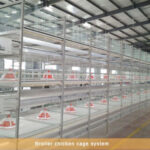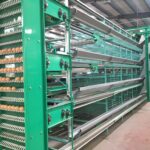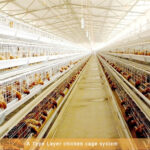How to manage caged layer chicken in summer?
The summer weather is hot, and the egg production rate will drop, especially after entering the sky, so the farmers need to do the following management to ensure the egg production rate of the laying hens in summer.
1. Strengthen ventilation and ventilation. Intensified ventilation in the summer can both cool down and keep the air fresh. The mechanically ventilated house is used to open the fan. If the house is too long (more than 70 meters), a relay fan can be installed in the middle. When ventilation is concerned, close the doors and windows on both sides, and the air inlets corresponding to the exhaust fans are all open; in the naturally ventilated house, all doors and windows should be opened, but there should be no screens or screen doors to prevent mosquitoes from entering. Good ventilation and ventilation measures can speed up the heat dissipation of the chicken body. Conditional chicken farms should be equipped with exhaust ventilation equipment or general blowers. The longitudinal ventilation of the axial flow fans is the best. Practice has proved that good ventilation measures can reduce the temperature from 3 ° C to 8 ° C. When the temperature rises above 25 °C, it is necessary to open the window in time to install the ventilation screen; when the temperature is higher than 30 °C, the shade shed should be built on the activity site closer to the chicken house. The size of the pergola is similar to that of the chicken house, but should be higher. The chicken house is about 50 centimeters.
2. Implement evaporation to cool down. In the case of high temperature and low humidity (generally relative humidity below 70%), evaporation and cooling methods such as wet curtain, spray and roof spray can be adopted. The wet curtain is cooled by installing a wet curtain at one end of the long shaft of the chicken house and an exhaust fan at the other end. After opening the exhaust fan, forced air enters the house through a wet curtain with circulating water, which can achieve the purpose of cooling (generally reducing the temperature inside the house by 5 ° C ~ 8 ° C). The spray cooling is to directly spray the chicken body with a high pressure or low pressure spray system, and the water mist absorbs part of the heat to achieve the purpose of short-term cooling. In the case of hot, high temperature and poor ventilation, when the temperature is high at noon or afternoon, the fresh water can be cooled with chicken spray by high-pressure spray gun or sprayer to relieve and absorb the heat of the house. It is a heatstroke prevention and maintenance. An effective method of high yield. However, the spray cooling in the house is a short-term behavior. When the temperature is too high and the humidity is low, in order to avoid the death of the chicken, it can be used for a short time. If the spraying time is too long, it will not only reduce the temperature, but also increase the temperature. The humidity of the big chicken house increases the difficulty of heat dissipation. By directly spraying the roof of the chicken house, the lost water can take away the heat of the roof to achieve the purpose of cooling. Evaporative cooling is a better cooling method at present, but it should be noted that when using a wet curtain to cool down, there should be an openable air inlet near the wet curtain. When the humidity exceeds 70%, the wet curtain should be closed and opened. Ventilation at the air inlet.

3. Reduce solar radiation. Reasonable house construction is one of the key measures to reduce the effects of heat stress. The ideal house should be best in east and west, minimizing solar radiation. The height of the ridge should not be too low, preferably 5.0 to 5.2 meters. Roofs and walls can be painted white or covered with reflective materials, and shade nets can be placed 30 to 50 cm from the roof of the house to reduce heat absorption. The roof is treated with heat-insulating materials, painted with white paint, and vent holes are provided. It is also possible to plant large-leaf crowns such as paulownia, paulownia, and white poplar on the sunny side of the chicken house, or to set up a shaded awning for the chicken house. Generally, chicken farmers can adhere to the principle of early morning and evening, that is, when the summer day is bright, the chickens are placed on the activity ground to feed, and the chickens are circled after dark. Try to reduce the time the laying hen stays in the hen house. After entering the raft, you can also put some wooden frames under the pergola for the chickens to inhabit.
4. Supply cool drinking water. Water participates in many biochemical reactions in the body and plays an important role in regulating body temperature. Providing adequate, hygienic and cool drinking water to laying hens in summer is a key factor in ensuring the health and productivity of the flock. There is no sweat gland in the body of the chicken. In the high temperature environment, the main heat dissipation method is respiratory evaporation and heat dissipation. By increasing the respiratory rate, a large amount of water is exhaled and the heat in the body is taken away. Tests have shown that chickens drink about 250 to 300 ml per day at 20 ° C, and when the temperature rises to 35 ° C, the amount of water will increase to 500 to 600 ml. Therefore, in order to ensure heat dissipation, it is necessary to ensure that sufficient cool drinking water is supplied during the hot summer. At the same time, drinking water in summer is easy to be sun-heated, drinking fountains should be placed in the shade, and water should be changed frequently. It is best to let the laying hens drink the well water just hit to reduce the temperature inside the laying hens.
5. Reduce the density of poultry battery cages. Laying hens are particularly afraid of heat. In summer, people should reduce the stocking density of chickens in time according to the rising temperature. The density of flocks should be based on ambient temperature, humidity and the type of house. In the hot summer, reducing the stocking density can effectively reduce the small ambient temperature in the house, which is of great significance in production practice. When captive laying hens enter the summer, it is better to raise 5 per square meter; in summer, it can be reduced to 4 per square meter.









